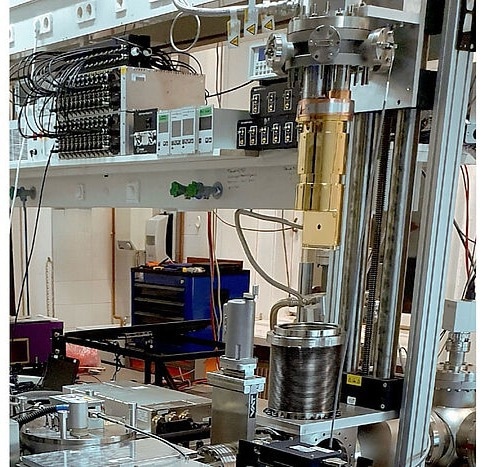A multinational research team at the University of Vienna, under the direction of quantum physicist Markus Arndt, has made significant progress in the identification of protein ions. At low energies, superconducting nanowire detectors outperform conventional ion detectors in terms of detection efficiency by a ratio of up to 1,000 due to their high energy sensitivity, which allows for about 100% quantum efficiency.
 View of the SuperMaMa laboratory at the University of Vienna. The hanging gold-plated insert is the radiation shield behind which the superconducting nanowire detectors are installed. Image Credit: Quantennanophysik @ Universität Wien
View of the SuperMaMa laboratory at the University of Vienna. The hanging gold-plated insert is the radiation shield behind which the superconducting nanowire detectors are installed. Image Credit: Quantennanophysik @ Universität Wien
Unlike traditional detectors, they are also capable of differentiating macromolecules based on their impact energy. This gives mass spectrometry extra information and enables more sensitive protein identification. The journal Science Advances published the study’s findings.
Protein research, diagnostics, and analytics are just a few of the life sciences fields that find macromolecules' detection, identification, and analysis intriguing. Mass spectrometry is a widely used detection device that examines the strength of signals produced by a detector and often divides charged particles (ions) based on their mass-to-charge ratio.
This details the relative abundance of the various ion types and the sample’s composition. Superconducting nanowire detectors have allowed an international team of researchers to overcome the constraint that traditional detectors could only achieve high detection efficiency and spatial resolution for particles with high-impact energy.
Joined Forces for Low-Energy Particles
A European consortium led by the University of Vienna and including partners from Delft (Single Quantum), Lausanne (EPFL), Almere (MSVision), and Basel (University) indicates for the first time the potential of superconducting nanowires as superior detectors for protein beams in quadrupole mass spectrometry. A quadrupole mass spectrometer receives the ions from the sample to be examined and filters them.
If we now use superconducting nanowires instead of conventional detectors, we can even identify particles that hit the detector with low kinetic energy.
Markus Arndt, Project Leader, Quantum Nanophysics Group, Faculty of Physics, University of Vienna
Superconductivity, a unique material feature of the nanowire detectors, makes this feasible.
Getting There with Superconductivity
The secret to this detecting technique is that at extremely low temperatures, nanowires transition into a superconducting state where they lose their electrical resistance and permit lossless current flow.
A quantum transition occurs when incoming ions excite the superconducting nanowires, resulting in a return to the normal conducting state. During this transition, the nanowires’ altered electrical characteristics are interpreted as a detecting signal.
With the nanowire detectors we use we exploit the quantum transition from the superconducting to the normal conducting state and can thus outperform conventional ion detectors by up to three orders of magnitude.
Marcel Strauß, Study First Author and Project Staff, University of Vienna
In fact, nanowire detectors redefine the capabilities of conventional detectors and offer an amazing quantum yield at remarkably low impact energies.
“In addition, a mass spectrometer adapted with such a quantum sensor can not only distinguish molecules according to their mass to charge state, but also classify them according to their kinetic energy. This improves the detection and offers the possibility for have better spatial resolution,” Strauß added.
In fields requiring high efficiency and strong resolution, particularly at low impact energy, such as mass spectrometry, molecular spectroscopy, molecular deflectometry, or quantum interferometry of molecules, nanowire detectors can find new uses.
Team and Funding
Superconducting nanowire detector research is headed by Single Quantum, ultracold electronics is provided by experts from EPFL-Lausanne, mass spectrometry is specialized by MSVISION, and chemical synthesis and protein functionalization are handled by University of Basel experts. The University of Vienna unites all the elements with its proficiency in superconductivity, molecular beams, and quantum optics.
The SuperMaMa project (860713), which aims to investigate superconducting detectors for mass spectrometry and molecular analysis, provided funding for the study. Funding for the study of the modified proteins was provided by the Gordon & Betty Moore Foundation (10771).
Journal Reference:
Strauss, M, et. al. (2023) Highly sensitive single-molecule detection of macromolecule ion beams. Science Advances. doi:10.1126/sciadv.adj2801.